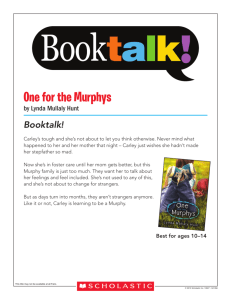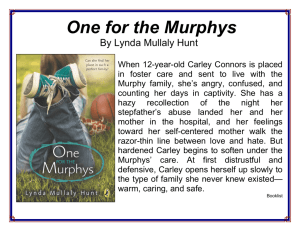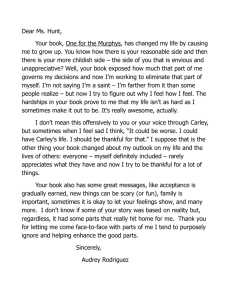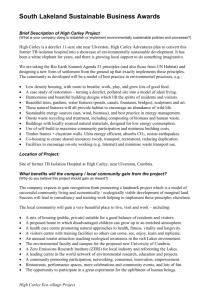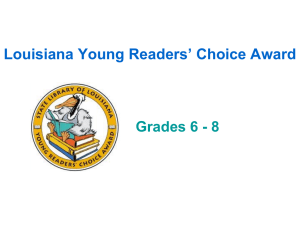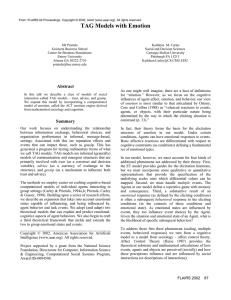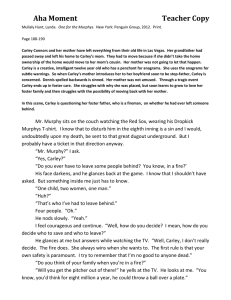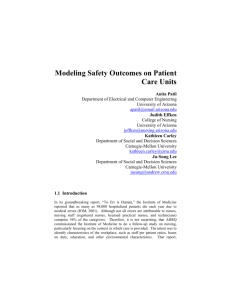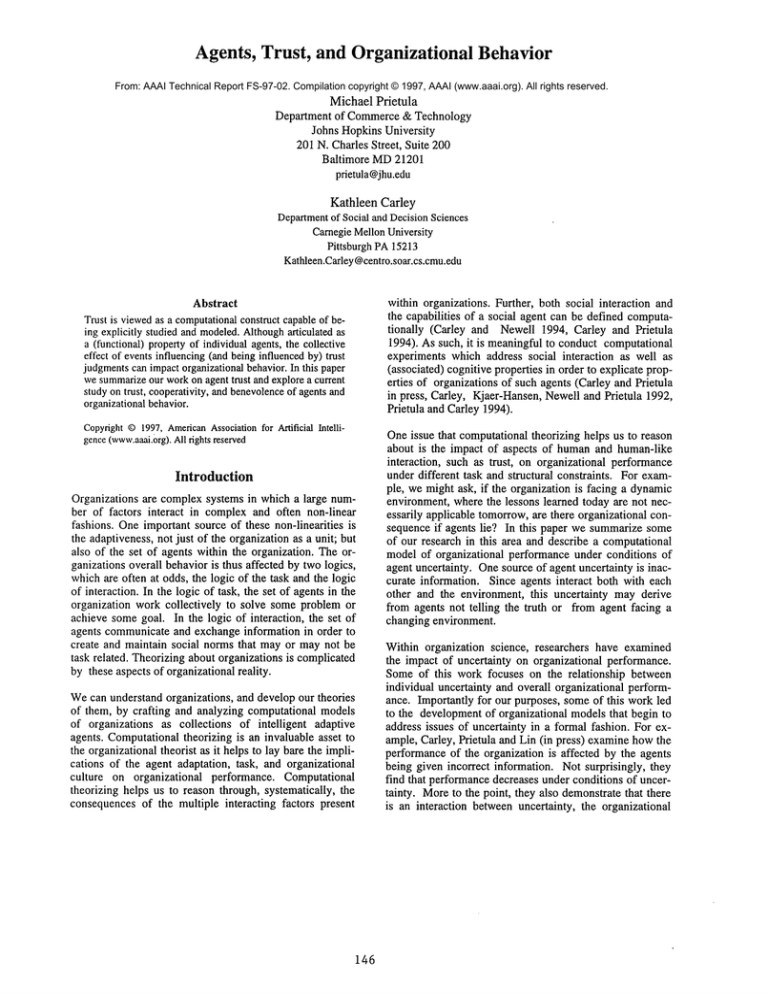
Agents, Trust, and Organizational Behavior
From: AAAI Technical Report FS-97-02. Compilation copyright © 1997, AAAI (www.aaai.org). All rights reserved.
Michael Prietula
Department of Commerce& Technology
Johns HopkinsUniversity
201 N. Charles Street, Suite 200
Baltimore MD21201
prietula@jhu.edu
Kathleen Carley
Department
of Social andDecisionSciences
CarnegieMellonUniversity
Pittsburgh PA15213
Kathleen.Carley@centro.soar.cs.cmu.edu
within organizations. Further, both social interaction and
the capabilities of a social agent can be defined computationally (Carley and Newell 1994, Carley and Prietula
1994). As such, it is meaningfulto conduct computational
experiments which address social interaction as well as
(associated) cognitiveproperties in order to explicate properties of organizations of such agents (Carley and Prietula
in press, Carley, Kjaer-Hansen,Newelland Prietula 1992,
Prietula and Carley 1994).
Abstract
Trust is viewed as a computational construct capable of being explicitly studied and modeled. Although articulated as
a (functional) property of individual agents, the collective
effect of events influencing (and being influenced by) trust
judgments can impact organizational behavior. In this paper
we summarize our work on agent trust and explore a current
study on trust, cooperativity, and benevolence of agents and
organizational behavior.
Copyright
©1997,American
Association
for Artificial Intelligence(www.aaai.org).
Allrightsreserved
Introduction
Organizations are complexsystems in which a large number of factors interact in complexand often non-linear
fashions. Oneimportantsource of these non-linearities is
the adaptiveness,not just of the organizationas a unit; but
also of the set of agents within the organization. The organizations overall behavioris thus affected by two logics,
whichare often at odds, the logic of the task and the logic
of interaction. In the logic of task, the set of agents in the
organization work collectively to solve someproblemor
achieve somegoal. In the logic of interaction, the set of
agents communicateand exchangeinformation in order to
create and maintain social norms that mayor maynot be
task related. Theorizingabout organizations is complicated
by these aspects of organizationalreality.
Wecan understandorganizations, and develop our theories
of them, by crafting and analyzing computational models
of organizations as collections of intelligent adaptive
agents. Computationaltheorizing is an invaluable asset to
the organizationaltheorist as it helps to lay bare the implications of the agent adaptation, task, and organizational
culture on organizational performance. Computational
theorizing helps us to reason through, systematically, the
consequencesof the multiple interacting factors present
146
Oneissue that computationaltheorizing helps us to reason
about is the impact of aspects of humanand human-like
interaction, such as trust, on organizational performance
under different task and structural constraints. For example, wemight ask, if the organization is facing a dynamic
environment,where the lessons learned today are not necessarily applicable tomorrow,are there organizational consequence if agents lie? In this paper we summarizesome
of our research in this area and describe a computational
modelof organizational performance under conditions of
agent uncertainty. Onesource of agent uncertainty is inaccurate information. Since agents interact both with each
other and the environment, this uncertainty mayderive
from agents not telling the truth or from agent facing a
changing environment.
Within organization science, researchers have examined
the impact of uncertainty on organizational performance.
Someof this work focuses on the relationship between
individual uncertainty and overall organizational performance. Importantly for our purposes, someof this workled
to the developmentof organizational modelsthat begin to
address issues of uncertainty in a formal fashion. For example, Carley, Prietula and Lin (in press) examinehowthe
performanceof the organization is affected by the agents
being given incorrect information. Not surprisingly, they
find that performancedecreases under conditions of uncertainty. Moreto the point, they also demonstratethat there
is an interaction betweenuncertainty, the organizational
structure (teamversus hierarchy), and the division of labor.
Thus, someorganizations, just becausethey have different
structures maybe less affected by uncertainty (Carley
1991, Carley and Lin 1995). Differences at the individual
level can have profoundeffects on organizational performance; however,the strength of those effects dependson
the structure of the organization.
other agents can either tell the truth (report wherethey last
saw the needed item) or lie (purposely report that the
needed item is somewhereother than where they last saw
it). Theobjects in the warehouse,however,are not stationary. Specifically, as agents fill orders they maymovethe
items they do not needto other locations so that they can
access the items they do need. The fact that agents can
moveitems makesthe environmentvolatile.
A Turing Effect
Oneissue is the effect that crafting informationand advice
through a particular medium-- the computer. However,it
is not simply the medium,it is the context in which the
messageis presented. Onepoint of impact of a system is
the effect it can havein delivering advice to a human,who
then subsequentlymakesdecisions based, in part, on that
advice. It is a formof exploringtrust. Onemodelof exploration in this arena is a "good-bad"modelin which the
advice is either right or wrong.A moreelaborate modelis
the crafting of a richer context in which the "right or
wrong"advice appears.
In Lerch, Prietula and Kulik (1997), a series of humancomputerinteraction experimentswere conducted, comparing the howtrust levels varied with howthe source of advice wascharacterized over the computer.That is, all advice was received as a formof email, but the source of the
advice was differentially described (humanexperts, expert
system, and peers). Results revealed a "Turing effect" in
which the characterization of advice as comingfrom an
expert systemhad significant effects on trust (e.g., they
trusted the expert systemsless than the humanexperts). In
addition, the results providedinsight into howthese subjects "viewed"as an internally defined model(e.g., expert
systems could not exert "effort," but humanscould). Expert systemsare seen, as characterized in these studies, as
significantly different types of creatures. Furthermore,evidence reveals possible sources for the Turing effect and
demonstratesthat manipulationof howadvice is characterized can influence trust judgments(Lerch, Prietula, Kim
and Buzas 1997).
ComputationalStudy 1
Demonstratingthat differential trust judgmentsexist and
can be manipulated on an individual level, we moveto
computationalagent research, we use a multi-agent model
of teamworkin which a collection of Soar (Laird, Newell
and Rosenbloom
1987) agents are working collectively to
accomplisha generic search task, which is viewedisomorphically as search on the internet (e.g., Carleyand Prietula
in press), or searching for items in a warehouse(Prietula
and Carley 1994). Viewedfrom the latter perspective, each
agent has task knowledgeabout howto get orders and how
to tell whenan order is filled. Eachagent movesabout in
the warehouselocating items to fill the order. Agentscan
and do interact. Oneformof interaction is that agents can
ask each other wherethe items they needare located. They
are seeking simple advice. In response to this query, the
147
Thesize of the organization and the trustworthiness of the
agents interact. Thus, as the size of the organization increases organizations of trustworthy agents ask and answer
morequestions; whereas, organizations of non-trustworthy
agents ask and answerfewer questions. This is simply the
effect of the value of information. Moreaccurate information increases the willingness to ask questions. Moreinaccurate information decreases the willingness to ask
questions. However,the effects are not linear. There is
also an impactof environmentalvolatility. Specifically, as
the size of the organizationincreases the effects just mentioned continue to occur but at decreasing rates. As organizations increase in size the environment becomes
more volatile. Thus, because items are moving, honest
agents appear dishonest and dishonest agents appear honest. Wewould speculate that eventually there maybe a
point wherevolatility is sufficiently high that both curves
"turn" and no differenceis discernibledue to trust.
ComputationalStudy 2
Weare beginninga simulation study in whichtrust models
from empirical humanstudies are woveninto simple computational models of groups, in the fashion described
above. Specifically, we reimplementedthe Plural-Soar
modelinto a less-cognitive, agent-basedform. As the prior
research demonstratedthe general nature of trust judgment
deliberation, the particular deliberation modelcould be
extracted from the data and crafted directly in algorithmic
form.
The task is the same as previously described: a set of
agents, that repeatedlygo to a particular location to acquire
an item to find, then proceed to search at different locations for that item. There are three componentsto their
social behavior: honesty(will they lie or not), benevolence
(how forgiving are they), and cooperation (under what
circumstances to they give advice). In this paper we hold
benevolence and cooperation constant -- they are quick
forgivers and they cooperate whenthey have the first opportunity. Wevary the first social component:whether
they lie or not aboutthe location of an item.
In addition, each agent has an item-memory(it recalls
where it has encountered all items), a social memory(it
recalls the value of the advice from other agents), and
communication
capability (it can ask and receive advice).
All three work to define the social interaction among
agents. In this study, the nature of the interaction is as fol-
lows. Agents are either Liars or they are Honest. Essentially, this defines how an agent responds to a general request for advice. An Honest agent will respond directly to
the questioning agent if it knowsthe location of the item in
question. A Liar agent will respond to any request for advice, supplying incorrect location information. An agent,
however, recalls the advice provided by an agent, and engages a simple social judgment model of advice acceptance, based on three judgment states: trustworthy, risky,
and untrustworthy. Good/bad advice moves the judgments
up/down. Advice from risky/untrustworthy
agents is not
accepted and questions from them are not answered (unless
the answering agent is a Liar). If an agent is unforgiving,
the untrustworthy state is absorbing - an agent deemed
untrustworthy remains so judged. As noted, all agents in
this study are benevolent. It is a forgiving group.
The general model consists of 10 item locations (where
items are stored), an order queue (where requests are
taken), and a delivery queue (where items are taken).
total of twenty unique items were in the order queue (nonredundant) and each agent takes one order at a time. The
purpose of this preliminary study is simple. We wish to
explore the extent that misinformation can impact organizational performance and behavior. Our model should
generate the fundamental collective behaviors it purports to
explain.
Results
The first questions address the general impact lying would
have on group behaviors, thus serving as a baseline for
subsequent studies. Table 1 summarizes the Total Moves
taken to complete the 20 item task by two types of groups:
all Liar agents and all Honest agents. This is varied by
groupsize for each (1, 2, 4, 6, 8, 10 agents).
I~I Liar Agents
4
I.’-- 6oo
4
6
-FBADAdvice
1
2
4
6
8
10
AgentGroup
Size
Thoughit is obvious that such relative relationships would
exist (i.e., Liar agent groups do worse than Honest agent
groups in stable environments), what is perhaps less obvious is the impact Liar agents would have in a Benevolent
group. This was explored as follows. The group size was
held constant at 10, while the numberof Liar agents in the
group was varied according to the schedule: 0, 1, 3, 5, 7, 9,
10. Thus, the extremes considered are the prior reported
conditions: all Liar agents, all Honest agents. It is the mix
that is of interest. Table 3 summarizedthe Total Movesfor
the seven groups simulated.
Table3
80O
700.
o>
5OO
g
i
2
Table2
16
I-- 600-
Table1
1
bad get worse and good get attenuated.
,
8
,
10
Number
of Agents
As can be seen in Table 1, a group of Liar agents quickly
incur penalties for their incorrect advice. The primary reason for this resides in the nature of the advice being generated by each group. In Table 2, we note the increasing
BADadvice (occurring in the Liar group) and the increasing GOODadvice (occurring in the Honest group). The
148
i
0:10
i
i
I
i
1:9 3:7 5:5 7:3
i
9:1
i
10:0
Liar-to-Honest
Agent
Ratio
The underlying events can be traced to the good and bad
advice generated under the different conditions. Table 4
summarizesthese results. Note that in Table 4, the amount
of Bad advice generated quickly dominates the organizational communicationat low ratio levels - a small number
of Liar agents can be extremely disruptive to group performance. Howthis occurs is two fold. First, in order to
provide Good advice, an agent must have good information. That is, the agent must know where a given item is
located. On the other hand, giving Bad advice requires no
information, unless an agent wishes to ensure that an item
is not in a knownlocation. These agents, however, simply
generate the same incorrect response. They do not search
their memoriesfor the correct one, nor do they require it. It
is the preference for these agents to trust communication.
Without a given advised location, they will engage in a
systematic search. However, information provided will
cause them to do directly to the suggested location
(without investigating interim locations). This has the effect, for Liar agents, of sending agents to false locations,
causing Location faults - going to a location without success. Table 5 summarizesthis result.
ential trust judgments and control (Turing effect), then the
impact of disseminated misinformation is understood.
Whether it is a "graduation talk" at MITor a "finding" of
findings in a sensational murder case, or a "report" of an
organizations investment risk. It might matter. It might
matter a lot.
References
Carley, K. and Newell, A. 1994. The Nature of the Social Agent,
Journal of MathematicalSociology, 19(4), 221-262.
Table 4
16
=
Carley, K., J. Kjaer-Hansen, J., Newell, A. and Prietula, M.
1992. Plural-Soar: A Prolegomenonto Artificial Agents and Organizational Behavior. In M. Masuchand M. Warglien (Eds.),
Artificial Intelligence in Organizationand Management
Theory,
Amsterdam:North-Holland.
=
12
10
8
-mm-BAD
Advice
~-GOODAdvic~
6
Carley, K. and Prietula, M. 1994. ACTSTheory: Extending the
Model of BoundedRationality. In K. Carley and M. Prietula
(Eds.), ComputationalOrganizationTheory, Hillsdale, NJ: Lawrence Erlbaum.
4
2
0
0:10
{3
[3
t
i
i
i
t
1:9 3:7
5:5
7:3
9:1
Liar-to-Honest Agent Ratio
[3
L
10:0
Carley, K. and Prietula, M. In press. WebBots,Trust and Organizational Science. In M. Prietula, K. Carleyand L. Gasser (Eds.),
Simulating Societies: ComputationalModelsof Institutions and
Groups. Cambridge, MA:AAAI/MIT
Press.
Table 5
Carley, K. and Lin, Z. 1995. Organizational Designs Suited to
High Performance Under Stress. IEEE - Systems Manand Cybernetics, 25(1), 221-230.
9O
=
=
¯
80
-5
Carley, K. 1991. Designing Organizational Structures to Cope
with CommunicationBreakdowns: A Simulation Model. Industrial Crisis Quarterly,5, 19-57.
70
~o
3
Carley, K., Prietula, M. and Lin, J. In press. Designversus Cognition: The Interaction of Agent Cognition and Organizational
Design on Organizational Performance. In R. Conte and E.
Chattoe (Eds.), Evolving Societies: The ComputerSimulation of
Social Systems.
50
40
i
0:10
i
i
,
i
~
1:9
3:7
5:5
7:3
9:1
Liar-to-Honest Agent Ratio
i
10:0
Conclusion
Wehave presented an exploratory analysis of the relationship between an affective response, trust, and organizational performance. Further research in this area needs to
explore the impact of other affective responses. Individual
agents develop cognitive coping mechanisms for dealing
with uncertainty, and their affective response to this uncertainty. These individualized cognitive coping mechanisms
may be, and are often assumed to be, detrimental to the
organization as these cognitive mechanisms may lead to
individuals acting in morerigid, less flexible, less efficient
fashions. Note, however, the impact that wrong information, presented at a high rate, can influence individual and
collective action. The combination of misplaced trust and
benevolent nature can yield suboptimal decisions. The
model is necessarily incomplete and simple. Yet, as we
study the impact of wrong information (as a form of Lying) on the Internet, and the research which points differ-
149
Laird, J., Newell, A. and Rosenbloom,P. 1987. Soar: AnArchitecture for GeneralIntelligence. Artificial Intelligence, 33, 1-64.
Lerch, J., Prietula, M.and Kulik, C. 1997. TheTuringEffect: The
Nature of Trust in MachineAdvice. In P. Feltovich, K. Ford and
R. Hoffman(Eds.), Expertise in Context: Humanand Machine,
Cambridge, MA: AMITPress.
Lerch, J., Prietula, M., Kim,J., and Buzas, T. 1997. Unraveling
the Turing Effect: MeasuringTrust in MachineAdvice. Working
Paper, Graduate School of Industrial Administration, Carnegie
MellonUniversity, Pittsburgh PA.
Prietula, M. and Carley, K. 1994. Computational Organization
Theory: AutonomousAgents and Emergent Behavior. Journal of
Organizational Computing,4(1), 41-83.

